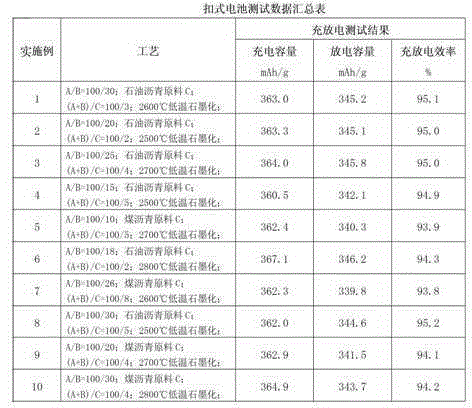Production method of composite artificial graphite anode material
A technology of artificial graphite negative electrode and production method, which is applied in the field of lithium-ion battery negative electrode materials, can solve the problems of poor processing performance and low capacity of coal-based needle coke, and achieve high production efficiency, increased furnace charging capacity, and low heating temperature Effect
- Summary
- Abstract
- Description
- Claims
- Application Information
AI Technical Summary
Problems solved by technology
Method used
Image
Examples
Embodiment 1
[0030] Weigh 100 kg of delayed petroleum coke raw material B, crush and classify, and control the median particle size to 5 μm.
[0031] Weigh 30 kg of pulverized raw material A micropowder, add 9 kg of pulverized raw material B micropowder, stir and mix at room temperature for 30 minutes, and then carry out fusion treatment for 20 minutes.
[0032] Weigh 30kg of the fused material, carry out modification treatment at 300-600°C, and then put it into a resistance graphitization furnace, and carry out low-temperature graphitization treatment at 2600°C.
[0033] Weigh all the graphitized materials for pickling, then wash with water and filter to become neutral, then dry at 120°C.
[0034] Weigh 20kg of the material after pickling, add 600g of raw material C petroleum asphalt powder, mix evenly, and then carry out carbonization treatment at 1300°C.
[0035] After carbonization, the material is cooled to room temperature, classified and sieved to obtain the product.
[0036] The ...
Embodiment 2
[0039] Weigh 100 kg of high-sulfur calcined petroleum coke raw material B, crush and classify, and control the median particle size to 4 μm.
[0040] Weigh 30 kg of pulverized raw material A micropowder, add 6 kg of pulverized raw material B micropowder, stir and mix at room temperature for 30 minutes, and then carry out fusion treatment for 20 minutes.
[0041] Weigh 30kg of the fused material, carry out modification treatment at 300-600°C, and then put it into a resistance graphitization furnace, and carry out low-temperature graphitization treatment at 2500°C.
[0042] Weigh all the graphitized materials for pickling, then wash with water and filter to become neutral, then dry at 120°C.
[0043] Weigh 20kg of the material after pickling, add 400g of raw material C petroleum asphalt powder, mix evenly, and then carry out carbonization treatment at 1200°C.
[0044] After carbonization, the material is cooled to room temperature, classified and sieved to obtain the product. ...
Embodiment 3
[0048] Weigh 100 kg of delayed petroleum coke raw material B, crush and classify, and control the median particle size to 5 μm.
[0049] Weigh 30 kg of pulverized raw material A micropowder, add 7.5 kg of pulverized raw material B micropowder, stir and mix at room temperature for 30 minutes, and then carry out fusion treatment for 20 minutes.
[0050] Weigh 30kg of the fused material, carry out modification treatment at 300-600°C, and then put it into a resistance graphitization furnace, and carry out low-temperature graphitization treatment at 2700°C.
[0051] Weigh all the graphitized materials for pickling, then wash with water and filter to become neutral, then dry at 120°C.
[0052] Weigh 20kg of the material after pickling, add 800g of raw material C petroleum asphalt powder, mix evenly, and then carry out carbonization treatment at 1400°C.
[0053] After carbonization, the material is cooled to room temperature, classified and sieved to obtain the product.
[0054] A ...
PUM
| Property | Measurement | Unit |
|---|---|---|
| Discharge capacity | aaaaa | aaaaa |
| Discharge capacity | aaaaa | aaaaa |
| Discharge capacity | aaaaa | aaaaa |
Abstract
Description
Claims
Application Information
 Login to View More
Login to View More - R&D
- Intellectual Property
- Life Sciences
- Materials
- Tech Scout
- Unparalleled Data Quality
- Higher Quality Content
- 60% Fewer Hallucinations
Browse by: Latest US Patents, China's latest patents, Technical Efficacy Thesaurus, Application Domain, Technology Topic, Popular Technical Reports.
© 2025 PatSnap. All rights reserved.Legal|Privacy policy|Modern Slavery Act Transparency Statement|Sitemap|About US| Contact US: help@patsnap.com

